The Netherlands welcomed Northern Ireland to the Johan Cruijff ArenA in a battle between the second and third-placed teams within Group C during Euro 2020 qualifiers. Ronald Koeman managed to guide his team to a 3-1 victory over Michael O’Neill’s Northern Ireland side. Although, it was not a straight forward win for the Oranje Dutch.
The score resulted in a switch of positions within the group, with three teams tied on points. Netherlands and Germany are tied for first with exactly the same goal difference statistics, while Northern Ireland dropped to third due to their inferior goal difference record. An additional point of context to note is that Germany and Netherlands have played one game less than Northern Ireland, potentially reinforcing their position as favourites to finish within the top two automatic qualification spots.
The Netherlands were large favourites going into the match and predictably dominated possession, although, this was not a game littered with ‘big chances’. Against the run of play, Northern Ireland were able to take the lead in the 75th minute and were hopeful of holding onto the lead to win the game. However, as the Netherlands upped the tempo and the Irish resistance tired, the hosts were able to equalise, before going on to win the game and earn a third goal in stoppage time.
This tactical analysis will investigate the match further and highlight how the Netherlands were able to come away with the points to secure top spot. The analysis will include match statistics, tactics, offensive, defensive and transitional components of play from each team as well as set pieces and other key match events.
Line-Ups
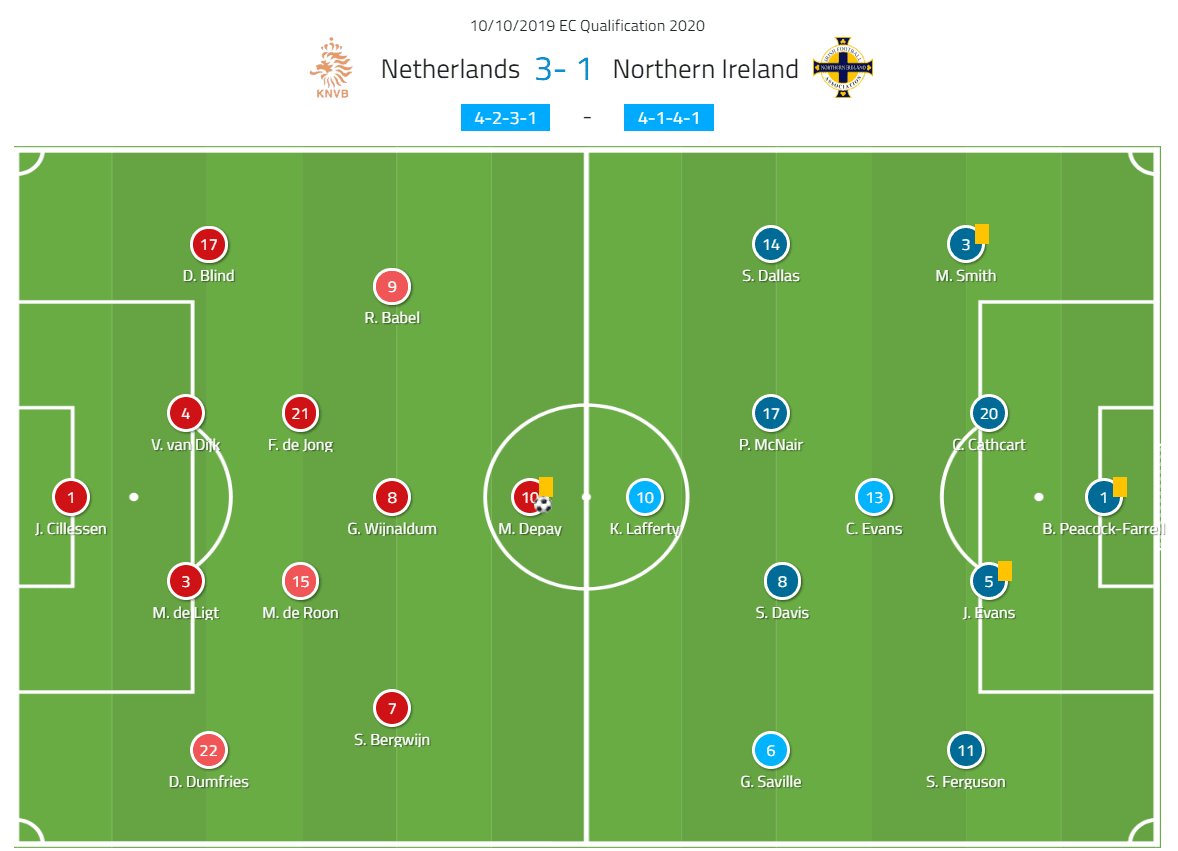
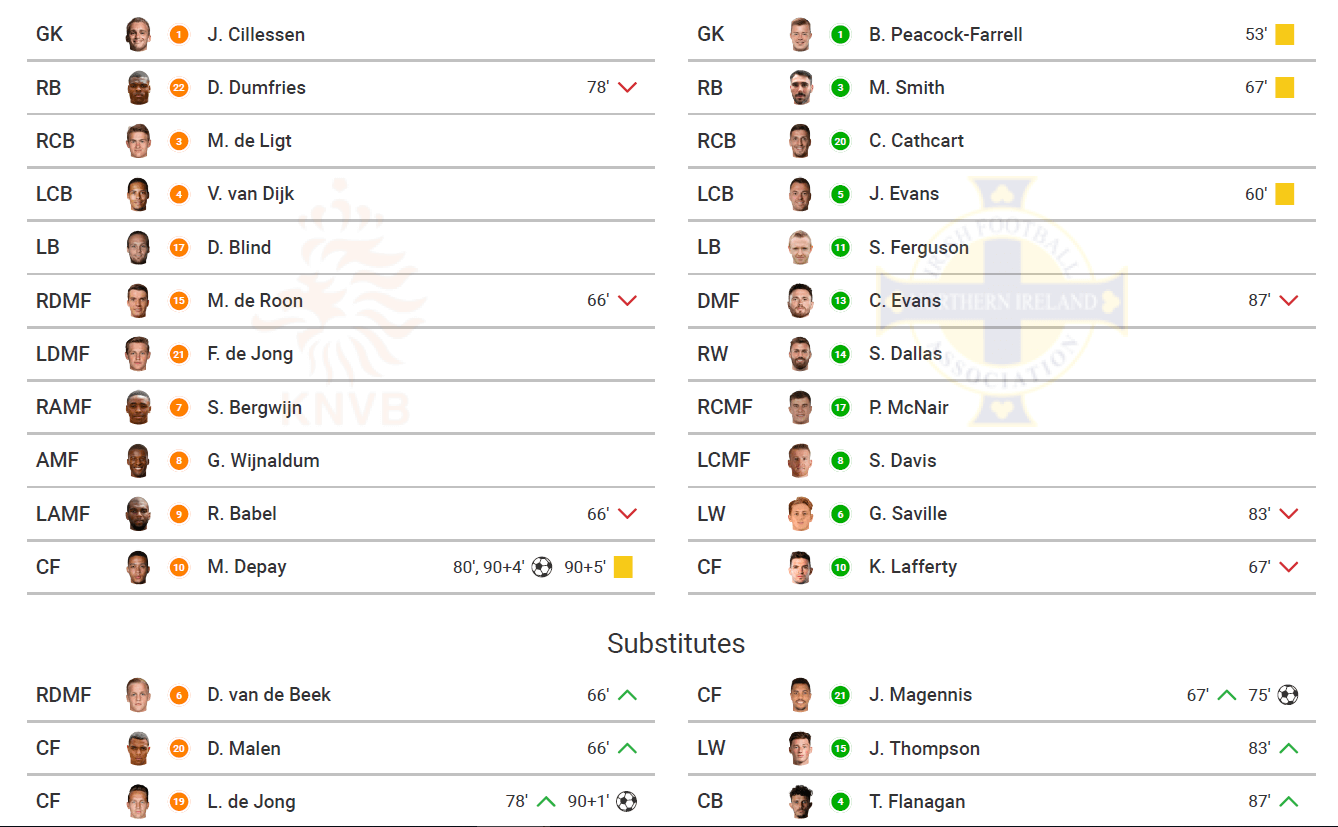
Average formations
Within their starting eleven, the Netherlands and Northern Ireland utilised varied formations in terms of general set up and the average positions in which the game dynamics led them. The Netherlands started with a 4-2-3-1 set up, a fairly balanced approach. Northern Ireland started the match in a 4-1-4-1, typically a more cautious, defensive set up. As the game progressed, formation changes occurred.
The Netherlands moved away from the 4-2-3-1 in favour of a 3-5-2, mainly in an attempt to increase their offensive flank play and which was typically the only area of the pitch which Northern Ireland offered space to play. In making this change, the Dutch were also able to have two strikers occupy opposing centre-backs and the penalty area.
Northern Ireland frequently adapted their system from a 4-1-4-1 to a 4-2-3-1, a 4-4-1-1 and finally a 5-4-1. Northern Ireland’s tactical tweaks were mainly due to defensive solidity. As the Netherlands were large favourites going into the match, the Oranje dominated possession, leaving the Irish to come up with solutions to stop the opposition playing.
When the Irish were able to take the lead thanks to Josh Magennis’ goal, they attempted to see out the game but the Dutch hit back. After the equaliser, Northern Ireland switched to their most defensive formation, the 5-4-1 to hold the draw, but were once again unable to reach the full-time whistle without conceding anew.
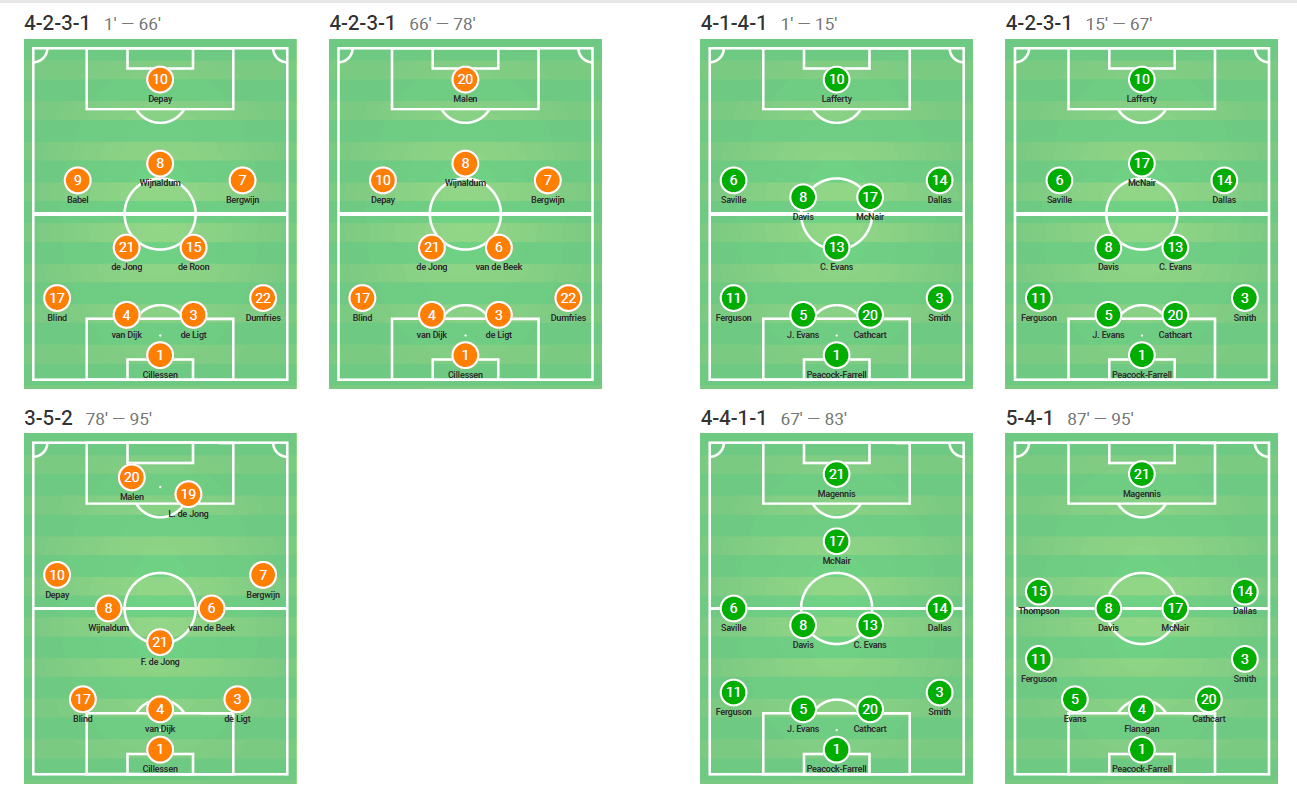
In terms of average formation, the Netherlands operated higher up the pitch, while Northern Ireland held a deeper average formation. This was expected due to the ball dominance displayed by the Netherlands displayed below.
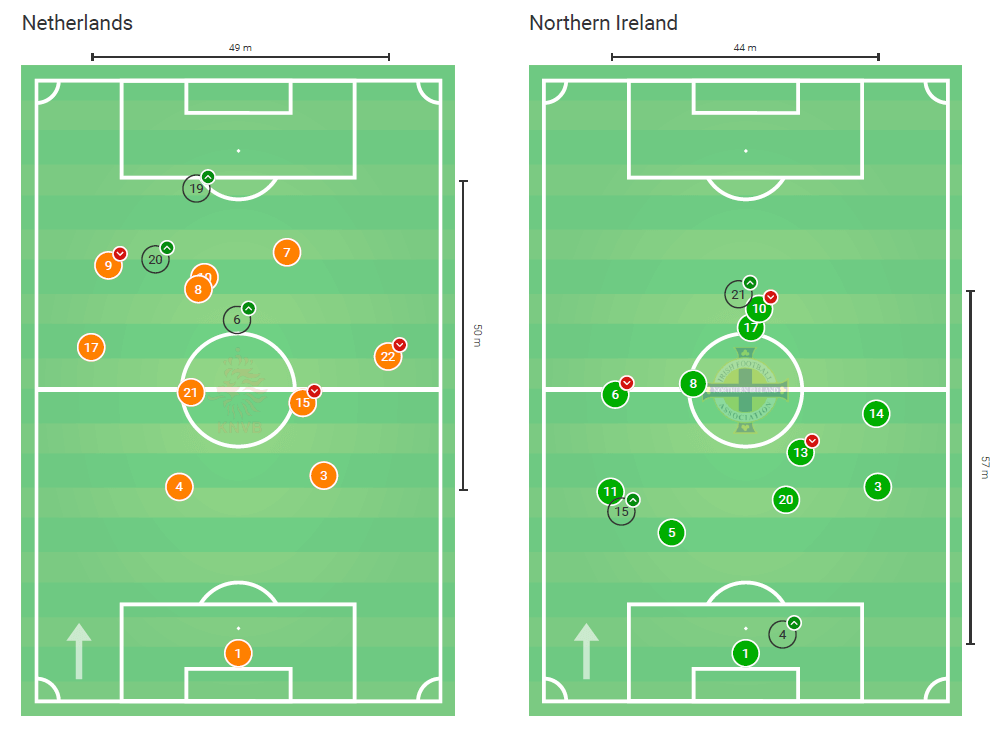
Match Stats
As predicted, with the Netherlands being the home team, with higher international rankings and perceived players of higher quality within their squad, the Dutch dominated possession and all other attacking metrics.
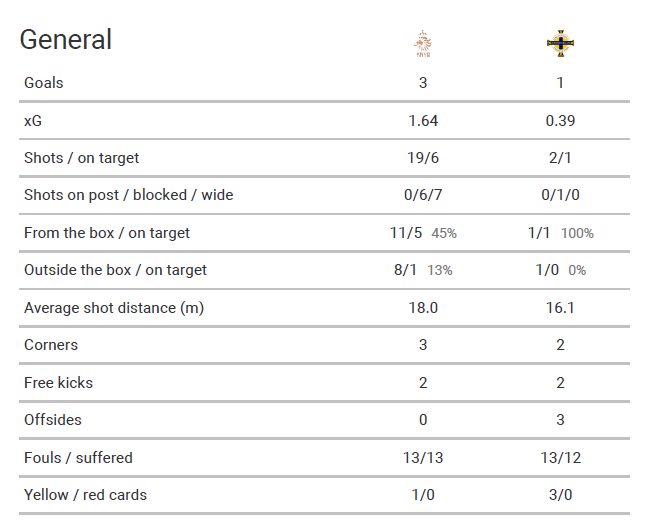
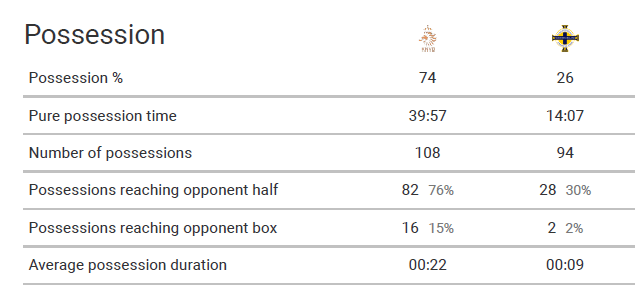
Such attacking superiority is also demonstrated in the xG for the game. The Netherlands could’ve expected to score at least one goal based on average finishing, whilst Northern Ireland could not have argued with the statistics if they left the match without scoring. However, one thing to say about Northern Ireland’s chance creation and finishing was that it was extremely effective.
The Irish had one shot in the whole match, one shot on target and scored one goal. Whilst they were unable to hold on for the win or draw, they can take credit in terms of efficient offensive play and the ability to restrict the dominant team to a relatively low xG when related to their possession and nullify the Dutch goal attempts until very late in the game.
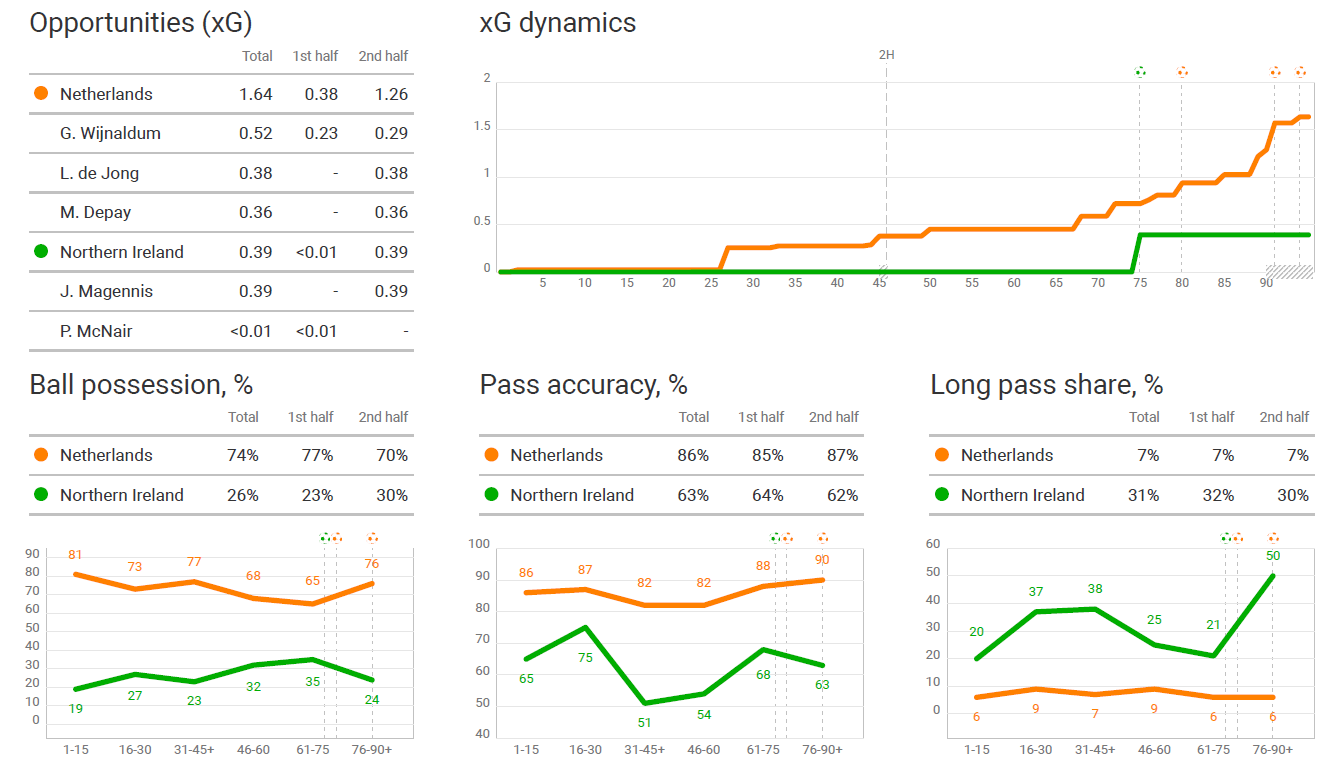
There were key differences between the statistics produced in the first half compared to the second half. These will be discussed in more context in future sections, however, the key stats which played a big part in the result of the match include Northern Ireland’s final 15-minute drop off in duel success, attacks per minute, pressing intensity, average defensive line and recoveries per minute. Essentially, a drop in all performance metrics displayed below.
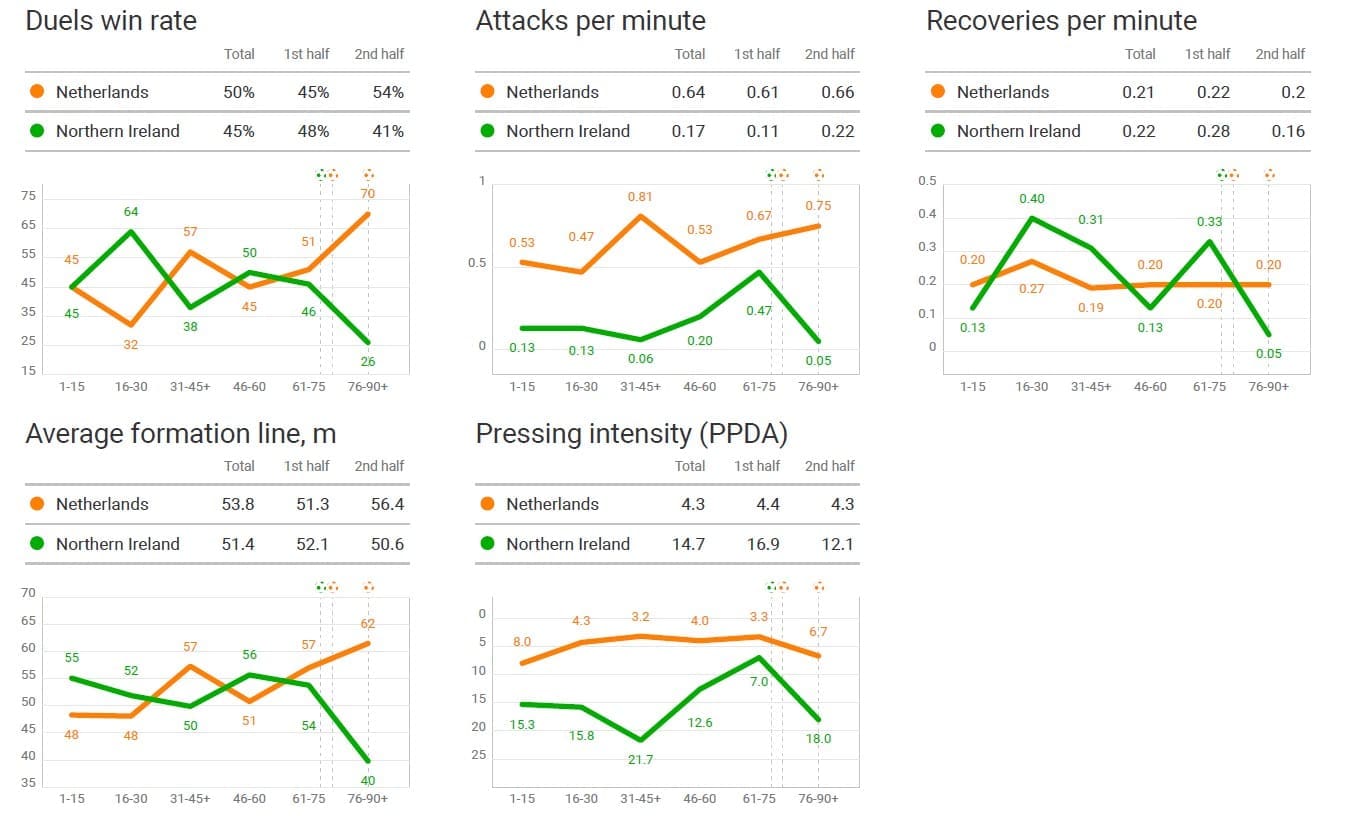
As stated in match descriptions and demonstrated via the match stats. Northern Ireland attempted to nullify the dominant side of the Netherlands. In doing so, they restricted the central areas of the pitch and forced the opposition to play wide in order to progress. While frustrated for the majority of the match, as highlighted by the xG momentum chart, the hosts did have the majority of their success down the left flank.
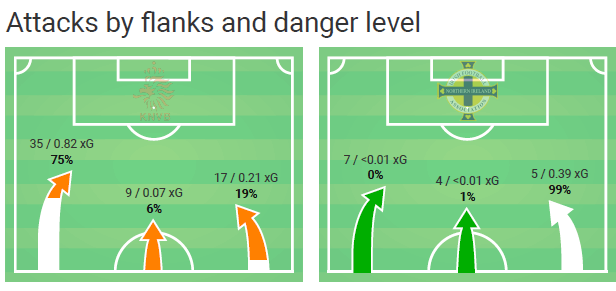
Netherlands attack, the stubborn Northern Ireland defence and intense pressing
Again, the possession stats show that the Netherlands dominated the ball within the match. With the ball, the Dutch operated using a short passing style, hence their low stat of only 7% of their passes being played long, and played out from the back with the goalkeeper and defenders involved in the build-up.
Despite attempts to play out from the back, the Netherlands were nullified on many occasions due to an intense, mistake provoking press from Northern Ireland. This press, was not a frantic pressing style in terms of its intensity, charging down every player, but an intense press within certain areas of the pitch in order to stop the Netherlands progressing up the pitch. Such pressing was mainly performed on the flanks, either high up the pitch to box the Netherlands in, or, part-way into Northern Ireland’s defensive half if the Irish had dropped back into shape.
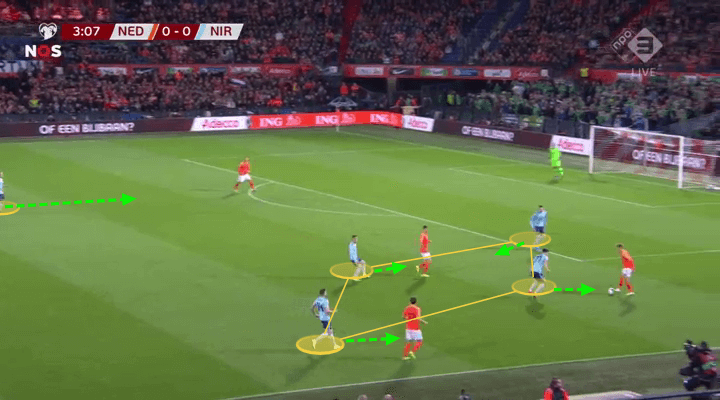
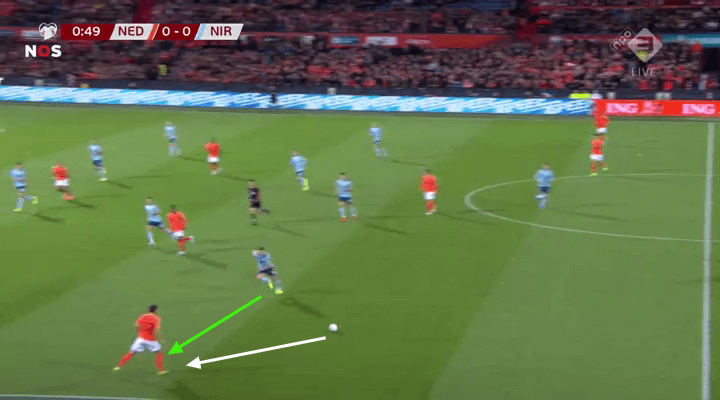
The style of the Irish press is evidenced in the PPDA statistics, their PPDA average of 14.7 suggests that the Dutch were allowed time to pass and move the football before engaging in a defensive action. This is true as Northern Ireland were rarely concerned the opposing centre-backs Virgil Van Dijk and Mathias de Ligt.
They allowed those players to pass the ball between themselves while preventing the Netherlands from gaining territory by marking all out-ball options, including midfield pivot Frenkie de Jong, before pressing once an attempt to play forward was made.
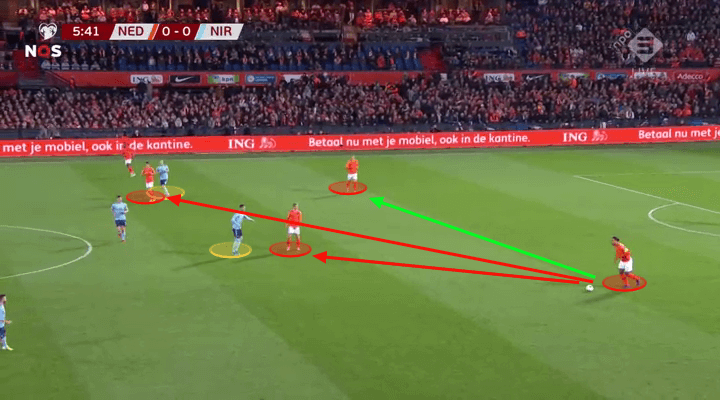
The Irish did not sit too deep, instead, they engaged in a compact block, with the first line of defence, the striker and midfielders, positioned just inside the defensive half. While such positioning was potentially susceptible to penetration should an accurate pass in behind or multiple accurate passes open up space behind the defence, overall it kept the Dutch away from the goal for large parts of the match. Rather than offering the hosts space to play on the edge of the box which would encourage through balls, crosses shots, Northern Ireland looked to squeeze up as part of a compact unit.
Given the defensive style of Northern Ireland in terms of allowing the centre-backs time on the ball, effective ball carriers, Van Dijk and De Ligt occasionally found success by stepping out of the defensive line and carrying the ball towards and occasionally through the Irish midfield. This confused the Irish players due to their system of marking offensive threats, the players found themselves caught in two minds. Did they go and nullify the ball carrier? Or, did they maintain shape and continue marking their Dutch counterpart? When Michael O’Neill’s players moved towards the ball carrier, that freed up an offensive player to be found with a pass to feet or into space.
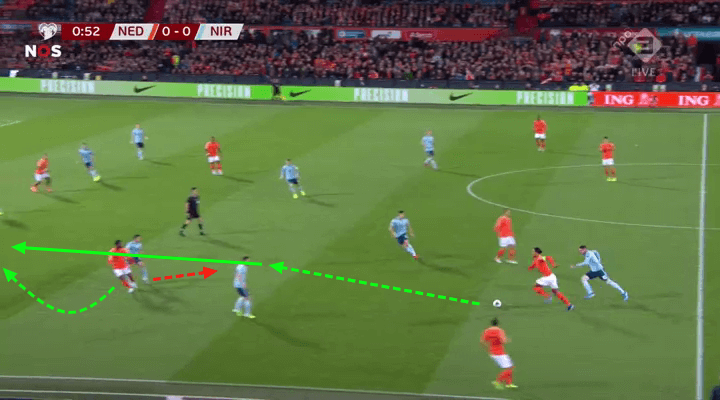
Throughout the majority of the match, the Netherlands progressive possession tactics were nullified by the Irish defensive system. Therefore, additional tactics were also sought by the Dutch when in possession of the ball. When the Irish squeezed up the pitch to press when the ball was deep in the Netherlands half, Van Dijk and De Ligt, who were offered more freedom than advanced options, occasionally attempted to hit long balls over the top of the Irish defence to try and find a winger making a run in behind.
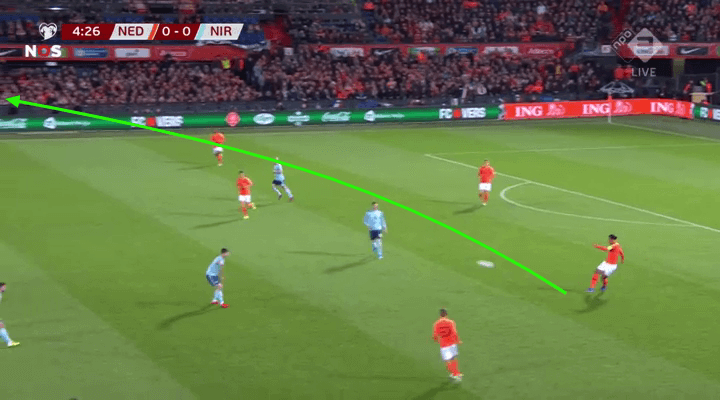
Despite the varied techniques of the Netherlands, their passing was slow and failed to break the Irish resistance down. Northern Ireland then took the lead, this will be discussed further when analysing the Irish in possession and in transition. After the Dutch conceded, it appeared to spark them into life, the players increased the tempo of their attacks, and while they were still restricted to mainly flank play, they obtained more advanced positions and took more risks with their movement.
Before the goal, the Dutch used generic aerial crosses, crosses which were easy to deal with by the Irish centre backs, but, after conceding, the hosts also adapted their crossing style to include low crosses in an attempt to create more opportunities. This occurred late in the game as the Netherlands were able to score in the 80th minute and then again in the 91st minute, both from varying types of crosses from the left flank.
The Irish drop-off
Another key reason why the Netherlands were able to equalise and go on to win the game is the drop off in offensive and defensive performance by Northern Ireland. Yes, the Dutch increased their tempo and took more risks, but, the impact of the Dutch pressure and fatigue ultimately contributed to the result. Northern Ireland dropped off in terms of their defensive line, the number of ball recoveries per minute, pressing intensity, duel success and attacks per minute. In contextual terms, they allowed the Dutch to move the ball closer to their goal, pressed less, won the ball back fewer times, could not attack as much to earn respite and were beaten in individual duels.
This allowed their opponents time and space to exploit the left flank and deliver dangerous crosses which resulted in goals. From the Netherlands perspective, this was an exciting comeback win. For Northern Ireland, after the effort expended to nullify the Dutch for so long and even take the lead, the drop off in such metrics is understandable, however, if the Irish could’ve held the values they set for 75 minutes of the game, we may be talking about a win or draw for Northern Ireland away in the Netherlands.
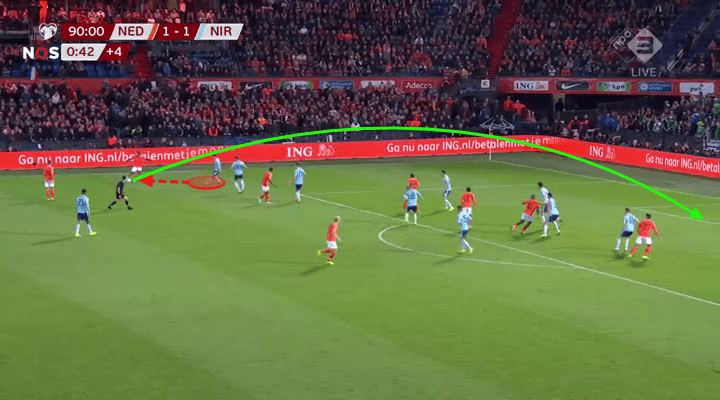
What did Northern Ireland do with little possession?
Given the possession dominance of the Netherlands, Northern Ireland’s possession sequences were short and can, therefore, be combined with their defensive to offensive transition analysis. When Northern Ireland did win the ball back, they did not try to build slow attacks. They looked to go from back to front quickly, with 31% of all passes played long, typically aiming for the flanks where a winger was waiting, or striker, Lafferty, had pulled away from the physical centre backs in order to find success and hold the ball up.
Even if the initial attack did not come to anything and they lost the ball, they would potentially win a free kick or throw-in. Alternatively, if the ball was lost, Northern Ireland would quickly transition into the press and attempt to box the Netherlands in, often being able to move up and gain yards by winning throw-ins which could then go in the box or be the catalyst for a rare offensive sequence.
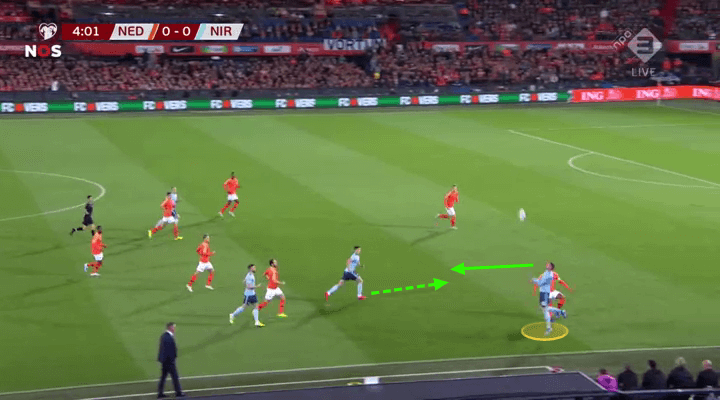
The opening goal came from a similar sequence as described. Ireland attacked down the left flank, the original attack came to nothing but a throw-in deep in the Dutch half was won. This allowed Northern Ireland to reset their attack and attempt to create another chance. This was done, with some help from sloppy defending and potentially poor goalkeeper positioning, as Josh Magennis, who had only been on the pitch less than 10 minutes, headed home.
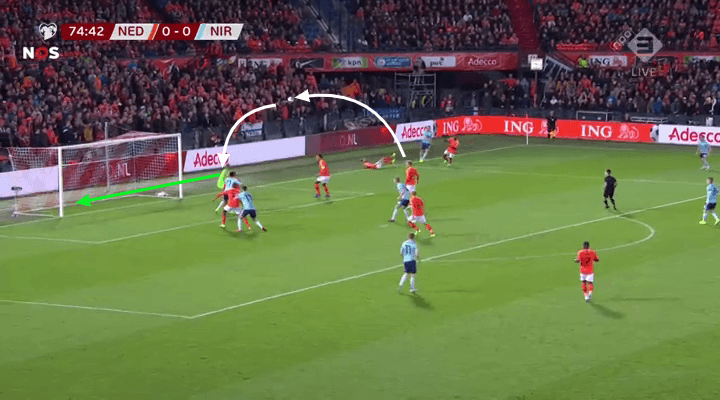
The Netherlands try to play quickly in transition
Due to the lack of space offered by Northern Ireland for the Netherlands to play in, the hosts often tried to counter-attack quickly where possible when they won the ball back, however, this rarely proved fruitful given Northern Ireland’s reluctance to send too many men forward, especially at 0-0, 1-0 to the Irish and even 1-1. In addition, the Irish attacks frequently involved interrupted structured game phases, for example, throw-ins and free kicks. When Northern Ireland lost the ball, they were eager to win it back with an intense press depending on the area of the pitch, this, therefore, restricted the Netherlands transition from defence to attack.
An instance where the Netherlands transition was successful is in the third goal. In stoppage time, as Northern Ireland pushed without defensive concerns, the Dutch won the ball, created a numerical overload on one side of the defence and sealed the victory with a goal.
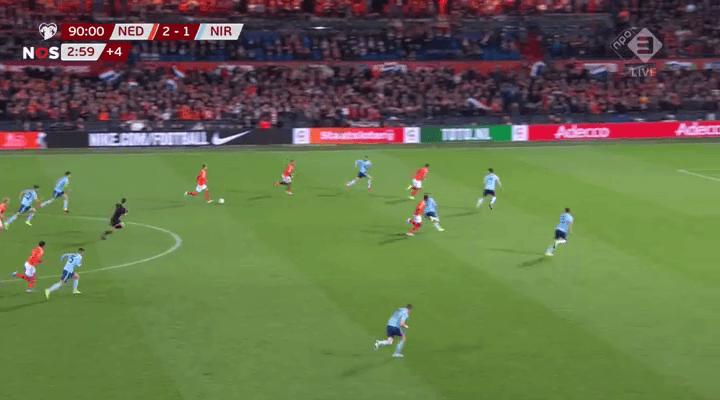
Set pieces
Surprisingly, given the lack of clear chances for the majority of the match in open play. Set pieces did not create any immediate chances for either team. Free kicks and corners offered a combination of sub-optimal delivery and effective defending.
Long throw-ins were utilised by Northern Ireland when they managed to move up the flanks, another benefit of their wide tactics, however, no real chances were created with the Irish having one shot on target all game.
The Netherlands utilised an interesting throw-in set up, although, again it did not directly create any chances. Memphis Depay would move towards the corner taker, turn around and let the taker throw the ball against his back in an involuntary one-two situation, adding flair and potential confusion to a set-piece many teams do not focus on.
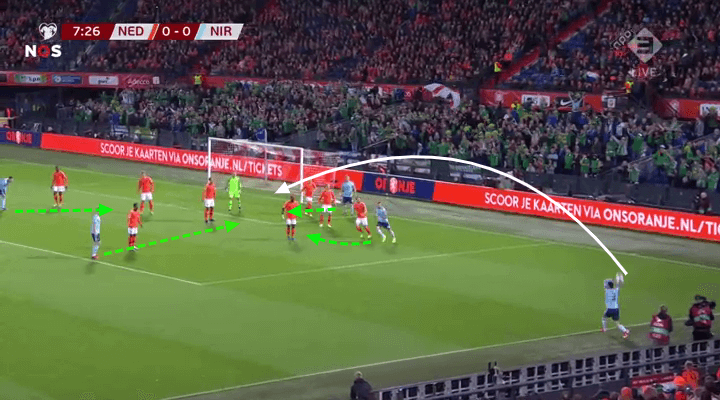
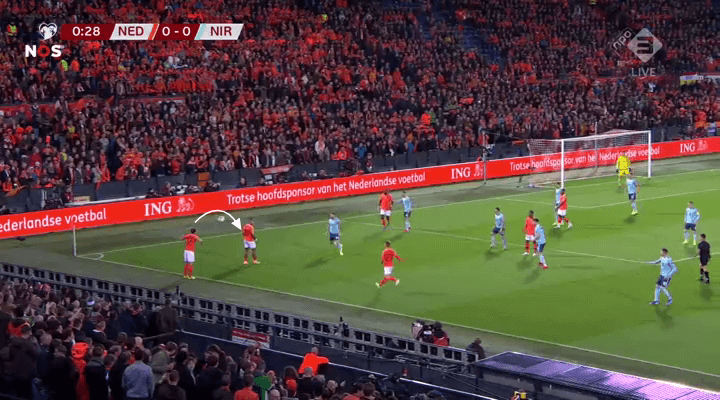
Conclusion
Overall, Ronald Koeman’s team walked away with three points. Michael O’Neill’s Northern Ireland used effective defensive tactics to frustrate the favourites for long periods. Northern Ireland managed to take the lead via a rare attack before fatigue and pressure from the Netherlands led to late goals for the hosts. The result leaves three teams on 12 points going into the final few qualifying matches in group C.
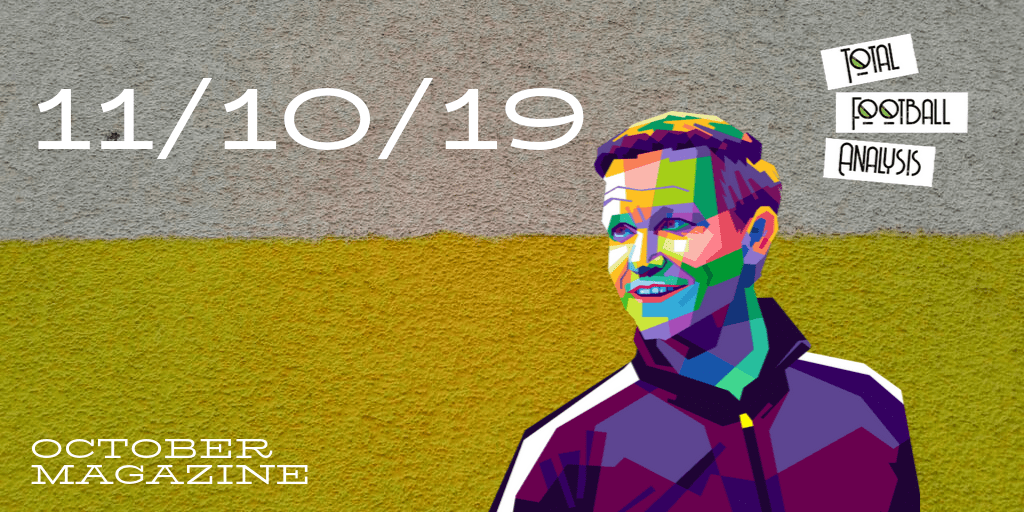
If you love tactical analysis, then you’ll love the digital magazines from totalfootballanalysis.com – a guaranteed 100+ pages of pure tactical analysis covering topics from the Premier League, Serie A, La Liga, Bundesliga and many, many more. Buy your copy of the October issue for just ₤4.99 here






Comments